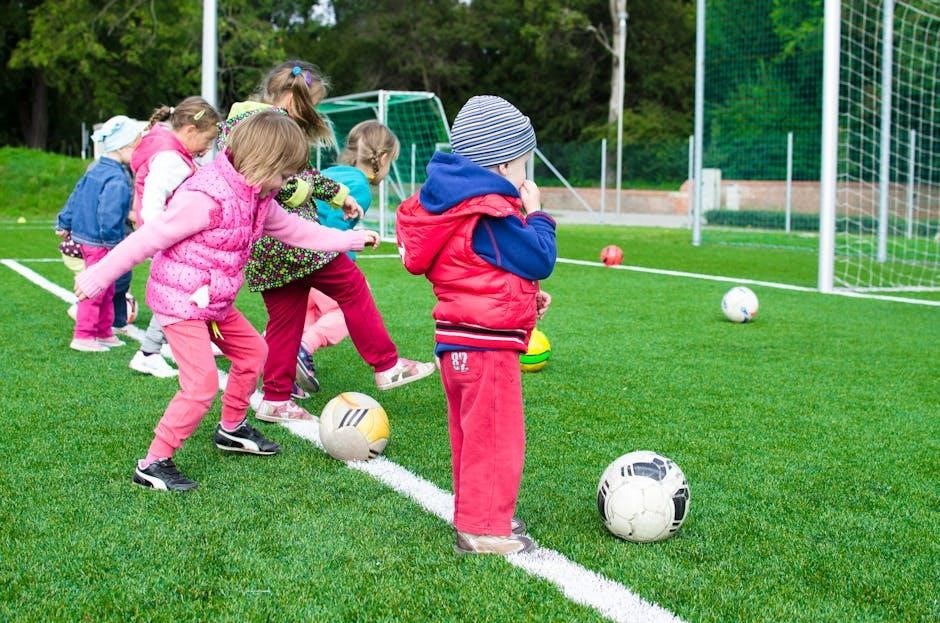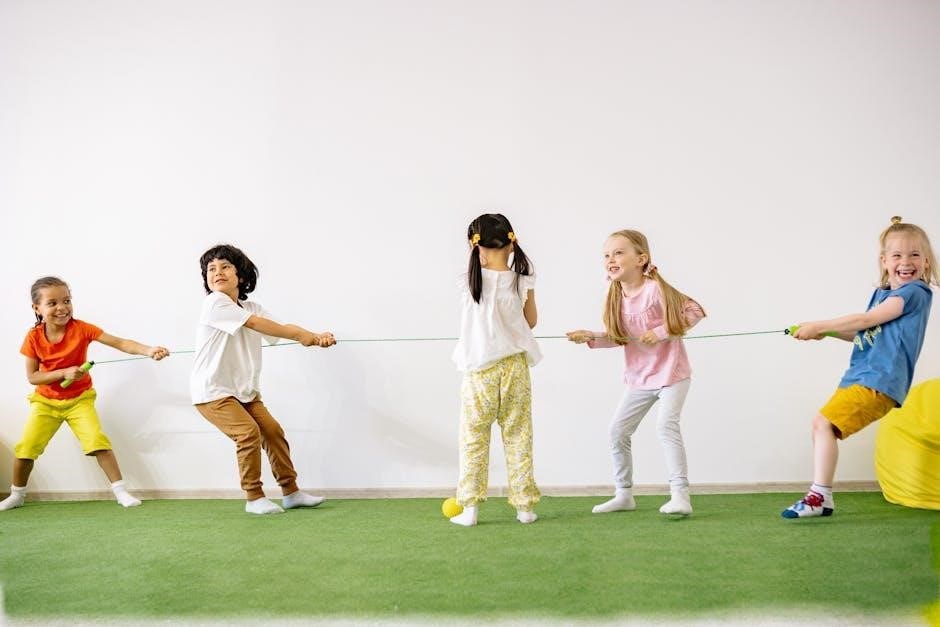A kindergarten packet PDF is a collection of educational resources, offering reading, math, and coloring activities. Designed for young learners, it supports cognitive and motor skills development. Easily accessible and printable, these PDFs provide engaging tools for early education.
1.1 Overview of Kindergarten Packets
A kindergarten packet PDF is a comprehensive collection of educational activities designed for young learners aged 4-6. These packets typically include reading comprehension worksheets, math exercises, alphabet and phonics practice, and art activities. They are structured to promote skill development, creativity, and engagement. Many packets are free to download and printable, making them accessible for both teachers and parents. They often align with developmental milestones, ensuring children are well-prepared for formal education. These resources are versatile, supporting learning in both classroom and home environments.
1.2 Importance of Using PDF Formats
Using PDF formats for kindergarten packets ensures accessibility and consistency. PDFs are widely compatible, allowing easy access across devices. They maintain formatting, crucial for worksheets and activities; Free and printable, PDFs enable cost-effective resource sharing. Parents and teachers can download and print them effortlessly, making learning materials readily available. PDFs also support interactive elements, enhancing engagement. Their reliability and versatility make them a preferred choice for educational content, ensuring high-quality learning tools for young students.
1.3 Benefits for Teachers and Parents
Kindergarten packet PDFs offer significant benefits for teachers and parents. Teachers can easily organize and distribute lessons, saving time and effort. Parents gain access to structured activities, fostering their child’s learning at home. PDFs are cost-effective and environmentally friendly, reducing paper waste. They also provide a consistent format, ensuring clarity and ease of use. Additionally, PDF packets encourage collaboration between teachers and parents, creating a cohesive learning environment. This resource supports both parties in nurturing a child’s educational journey effectively.

Structure of a Typical Kindergarten Packet
A typical kindergarten packet PDF includes reading comprehension, math activities, alphabet exercises, and color recognition, providing a comprehensive learning experience for young children.
2.1 Reading Comprehension Worksheets
Reading comprehension worksheets in kindergarten packets PDFs focus on early literacy skills, such as sequencing events, identifying main ideas, and recognizing sight words. These activities often include short stories, picture-based questions, and simple sentences to promote understanding. Many worksheets are designed to be engaging, with colorful illustrations and relatable themes. Parents and educators can use these resources to help children build a strong foundation in reading, fostering a love for stories and learning. These tools are easily printable and adaptable to various learning environments.
2.2 Math Activities for Early Learners
Kindergarten packet PDFs include math activities tailored for early learners, such as counting exercises, basic addition, and shape recognition. These worksheets often feature colorful illustrations and engaging layouts to capture young children’s attention. Activities like sequencing numbers, matching objects, and solving simple puzzles help develop problem-solving skills. Many packets also incorporate real-world applications, such as measuring lengths or identifying patterns, to make learning fun and practical. These exercises are designed to build foundational math skills in a playful and accessible way for children aged 4-6.
2.3 Alphabet and Phonics Exercises
Alphabet and phonics exercises in kindergarten packets are designed to introduce young learners to letter recognition and early literacy skills. Activities include tracing letters, matching uppercase and lowercase letters, and identifying sounds. Phonics exercises often feature word families, rhyming games, and blending sounds to form simple words; These exercises are typically presented with colorful illustrations and engaging layouts to keep children interested. Many packets also include interactive elements like fill-in-the-blank words or sequencing letters, helping children build foundational reading skills in a fun and structured way.
2.4 Color Recognition and Art Activities
Color recognition and art activities in kindergarten packets help children identify and name primary and secondary colors. These exercises often include coloring pages, matching games, and creative projects that encourage self-expression. Activities may involve sorting objects by color, drawing shapes, or completing patterns. Art exercises also aim to develop fine motor skills through the use of crayons, markers, or digital tools. Many packets incorporate seasonal or thematic elements, making learning fun and engaging while fostering creativity and an understanding of color theory basics.

Key Components of a Kindergarten Packet
A kindergarten packet PDF typically includes skill-focused worksheets, interactive activities, and assessment tools. These components are designed to promote early learning through structured and engaging exercises for young children.
3.1 Worksheets for Skill Development
Worksheets in kindergarten packets are tailored to enhance essential skills like reading, math, and alphabet recognition. They include activities such as tracing letters, matching shapes, and sequencing events. These exercises are designed to foster cognitive growth and fine motor skills. Interactive elements like coloring pages and simple puzzles keep children engaged while learning. The structured format ensures gradual skill progression, making them ideal for both home and classroom use. Free PDF downloads make these resources easily accessible for parents and educators to support early learning.
3.2 Interactive Activities for Engagement
Interactive activities in kindergarten packets include puzzles, matching games, and sequencing exercises. These engaging tasks encourage active participation, enhancing problem-solving skills and memory. Activities like “sequence daily events” or “match pictures” provide hands-on learning experiences. Coloring pages and simple crafts also foster creativity and fine motor skills. These activities are designed to be fun and educational, keeping young learners captivated while promoting overall development. They are ideal for both independent play and parent-child interaction, making learning an enjoyable experience.
3.3 Assessment Tools for Progress Tracking
Kindergarten packet PDFs often include embedded assessment tools to monitor progress. Worksheets feature quizzes and exercises that evaluate understanding and skill mastery. Activities like sequencing events or matching objects help track developmental milestones. These tools provide insights into a child’s cognitive and motor skills growth. Parents and teachers can use these assessments to identify strengths and areas needing improvement, ensuring tailored support for young learners. Regular feedback from these tools aids in creating personalized learning plans, fostering continuous development.

Benefits of Using Kindergarten Packets
Kindergarten packets enhance early learning by improving cognitive skills, fostering creativity, and promoting parent-child interaction. They provide structured activities that support academic and developmental growth effectively.
4.1 Enhanced Cognitive Development
Kindergarten packets PDFs boost cognitive development through engaging activities like puzzles, sequencing, and matching games. These exercises enhance problem-solving skills, memory, and logical thinking. Reading comprehension and math worksheets improve language abilities and numerical understanding, preparing children for academic success. Interactive tasks also foster curiosity and a love for learning, laying a strong foundation for future educational endeavors. These resources are designed to stimulate young minds and promote overall intellectual growth effectively.
4.2 Improved Motor Skills Through Activities
Kindergarten packet PDFs include activities that enhance motor skills, such as coloring, tracing, and cutting exercises. These tasks improve hand-eye coordination and dexterity, essential for writing and using tools. Interactive worksheets like puzzles and matching games also strengthen fine motor abilities. Additionally, gross motor skills are developed through movement-based activities, fostering overall physical coordination. These engaging exercises prepare children for tasks like using scissors and holding pencils, making them confident in their ability to complete school-related activities effectively.
4.3 Fostered Parent-Child Interaction
Kindergarten packet PDFs encourage active involvement between parents and children, creating meaningful learning opportunities. By working together on activities like reading, puzzles, and coloring, parents can guide their child’s development while strengthening their bond. These shared experiences foster a sense of collaboration and mutual support, helping children feel secure and motivated. Regular interaction also allows parents to monitor progress and celebrate achievements, reinforcing the importance of education and teamwork in early learning.

Finding and Creating Kindergarten Packets
Kindergarten packets are easily accessible online, with free PDF resources available for download. Parents and educators can also create customized packets tailored to specific learning needs.
5.1 Where to Find Free Kindergarten PDFs
Free kindergarten PDFs are widely available online through educational websites. Platforms like WorksheetFun, DailyEnglish123, and PreschoolWorksheets offer downloadable resources. These sites provide reading comprehension, math, and coloring activities tailored for children aged 4-6. Many PDFs are designed to boost literacy, numeracy, and creativity. Parents and teachers can search using keywords like “free kindergarten worksheets PDF” or “kindergarten activity packets” to find suitable materials. Ensure to download from reputable sources for quality and safety.
5.2 How to Create Customized Packets
Creating customized kindergarten packets involves selecting specific activities based on learning goals. Start by identifying the subjects and skills to focus on, such as reading or math. Use templates from educational websites or design your own worksheets. Tools like Canva or Google Docs can help format and organize the content. Combine activities into a single PDF using software like Adobe Acrobat. Ensure the packet is visually appealing and age-appropriate, with clear instructions for both children and parents. This approach allows for tailored learning experiences that cater to individual needs.
5.3 Tips for Effective Packet Utilization
For effective use of kindergarten packets, establish a consistent routine and encourage interactive learning. Use visual aids and hands-on activities to keep children engaged. Involve parents by providing clear instructions and fostering a collaborative learning environment. Monitor progress regularly and adjust activities to meet individual needs. Incorporate seasonal themes to maintain interest and make learning fun. Rotate activities to avoid repetition and ensure a well-rounded educational experience that aligns with developmental milestones.

Age Appropriateness of Activities
Kindergarten packets are designed for children aged 4-6, focusing on activities that align with developmental milestones. Worksheets and exercises are tailored to enhance visual perceptual and non-verbal reasoning skills.
6.1 Suitable Activities for 4-6 Year Olds
Kindergarten packets for 4-6 year olds include activities like sequencing events, alphabet tracing, and color recognition. These exercises promote literacy, numeracy, and fine motor skills. Interactive tasks, such as matching games and simple math problems, keep young learners engaged. The content is tailored to align with developmental milestones, ensuring age-appropriate challenges. Worksheets often feature visual aids to support understanding, making learning fun and accessible for early childhood development.
6.2 Aligning with Developmental Milestones
Kindergarten packet PDFs are designed to align with the developmental milestones of 4-6 year olds, focusing on cognitive, motor, and social skills. Activities such as sequencing events, alphabet tracing, and color recognition support fine motor development and problem-solving abilities. These resources are tailored to match the learning pace of young children, ensuring they build a strong foundation for literacy and numeracy. By incorporating age-appropriate challenges, the packets help children progress steadily, preparing them for future academic success.

Subjects Covered in Kindergarten Packets
Kindergarten packets cover essential subjects like reading, math, alphabet, phonics, and color recognition, with additional basics in science and social studies for well-rounded learning.
7.1 Reading and Literacy Skills
Kindergarten packets often include reading comprehension worksheets, alphabet recognition exercises, and phonics activities to build foundational literacy skills. These resources help children recognize letters, understand word formation, and develop basic reading comprehension. Activities like sequencing stories, matching letters to sounds, and identifying sight words are common. Such exercises foster a strong foundation for reading, preparing children for more complex literacy tasks in later years. Interactive elements like picture sequencing and word recognition games make learning engaging and fun.
7.2 Mathematics and Problem-Solving
Kindergarten packets often include math activities tailored for early learners, focusing on basic arithmetic, counting, and problem-solving. Worksheets may feature addition and subtraction exercises, number recognition, and shape sorting. These resources help children understand fundamental math concepts through engaging tasks like counting objects, matching numbers to quantities, and solving simple puzzles. Visual aids, such as number lines and shape recognition exercises, make learning interactive and accessible. Measuring activities and sequencing exercises further enhance problem-solving abilities, preparing children for more advanced math skills in the future.
7.3 Science and Social Studies Basics
Kindergarten packets often incorporate basic science and social studies content, introducing young learners to foundational concepts. Science activities may include simple experiments, plant life cycles, and animal recognition. Social studies elements focus on family structures, community helpers, and cultural awareness. Interactive exercises like matching games, labeling diagrams, and sequencing events encourage curiosity and critical thinking. These activities are designed to be engaging and age-appropriate, fostering an early appreciation for these subjects while developing observation and problem-solving skills.

Digital vs. Print Kindergarten Packets
Kindergarten packets are available in both digital and print formats, offering flexibility for educators and parents. Digital packets provide easy access and portability, while print versions offer tactile learning benefits.
8.1 Advantages of Digital Packets
Digital kindergarten packets offer unparalleled convenience and accessibility. They can be easily downloaded and accessed on various devices, making them ideal for remote learning. Interactive features like clickable links and animations enhance engagement, while the ability to print specific pages reduces waste. Digital packets are also eco-friendly, saving paper and storage space. Additionally, they can be updated effortlessly, ensuring content remains relevant and aligned with educational standards. This flexibility makes digital packets a preferred choice for modern educators and parents seeking adaptable learning tools.
8.2 Benefits of Traditional Print Packets
Traditional print packets provide a tactile learning experience, which is often more engaging for young children. They eliminate the need for digital devices, reducing distractions and allowing focused learning. Print packets are also versatile, as they can be used anywhere without requiring internet access. Additionally, they often include colorful visuals and hands-on activities that enhance sensory development. For many educators and parents, print packets remain a reliable and effective tool for fostering early education in a more traditional and accessible format.

Seasonal and Thematic Kindergarten Packets
Seasonal packets include holiday-themed activity sheets and summer bridge exercises, making learning fun and engaging. Thematic designs align with yearly events, fostering curiosity and creativity in young learners.
9.1 Holiday-Themed Activity Sheets
Holiday-themed activity sheets in kindergarten packets add festive fun to learning. They include puzzles, coloring pages, and reading comprehension exercises tied to celebrations like Christmas, Halloween, or Easter. These sheets often feature seasonal characters and themes, making learning engaging and relatable for young children; Activities like sequencing holiday events or matching festive objects enhance cognitive skills. Parents and teachers can use these sheets to connect educational goals with cultural and seasonal experiences, fostering both knowledge and joy in early learners.
9.2 Summer Bridge Packets for Continuity
Summer bridge packets are designed to maintain learning continuity during breaks. These PDF resources include activities that reinforce previous skills and introduce new concepts, ensuring a smooth transition to the next grade. They typically feature a mix of reading comprehension, math review, and engaging exercises. Parents can use these packets to keep children academically active over the summer, preventing learning loss and fostering a consistent educational routine. Many are available as free downloads, making them accessible for families seeking to support their child’s ongoing development.
Using Kindergarten Packets at Home
Kindergarten packets are valuable tools for home learning, offering structured activities that support skill development. Parents can use these resources to create engaging daily routines, fostering academic growth and reinforcing classroom lessons in a familiar environment.
10.1 Engaging Children in Daily Activities
Engaging children in daily activities using kindergarten packets fosters a love for learning. Parents can incorporate reading comprehension, sequencing events, and interactive PDFs into routines. Setting aside time each day for these activities creates consistency and fun. Interactive elements like coloring and phonics exercises make learning enjoyable. Parents should encourage participation, offering guidance while allowing independence. This approach helps children develop skills while strengthening parent-child bonds, making education a positive and shared experience at home.
10.2 Creating a Home Learning Routine
Creating a home learning routine with kindergarten packets ensures consistent skill development. Parents can dedicate specific times daily for activities, such as reading comprehension or math exercises. Using PDF packets, families can explore a variety of subjects in a structured yet flexible manner. Incorporating these resources into daily schedules helps children build a strong educational foundation while fostering a routine that promotes engagement and learning. Consistency is key to making home learning effective and enjoyable for young learners.
Kindergarten Packets in the Classroom
Kindergarten packets are essential educational tools in classrooms, offering structured activities that support group and independent learning. They enhance curriculum delivery and keep students engaged.
11.1 Integrating Packets into Lesson Plans
Integrating kindergarten packets into lesson plans enhances structured learning, offering activities aligned with curriculum goals. Teachers can incorporate reading, math, and art exercises seamlessly, ensuring a balanced approach. Packets provide ready-to-use materials, saving preparation time while catering to diverse learning styles. They support group and independent work, fostering engagement and skill development. By aligning packet content with daily objectives, educators create cohesive lessons that promote early literacy, numeracy, and creativity, ensuring a comprehensive learning experience for young students.
11.2 Managing Packet Distribution and Completion
Effective management of kindergarten packets involves organized distribution and clear instructions for completion. Teachers can assign specific pages or activities based on lesson goals, ensuring materials are used purposefully. Tracking progress through checklists or completion charts helps monitor student engagement. Collaboration with parents is key, as they often support packet activities at home. Providing digital access or printed copies offers flexibility, while offering guidance on time management helps students stay focused. Regular feedback and encouragement motivate young learners to complete their tasks successfully.
Assessment and Progress Tracking
Kindergarten packets often include assessment tools to track progress. Embedded worksheets help evaluate skills, while monitoring developmental milestones ensures tailored support for young learners’ growth.
12.1 Embedded Assessment in Worksheets
Embedded assessments in worksheets allow teachers and parents to evaluate a child’s progress subtly. Activities like sequencing, matching, and comprehension exercises are designed to gauge skills. These tools provide insights into cognitive development and identify areas needing support, ensuring tailored learning experiences for young students.
12.2 Monitoring Developmental Progress
Kindergarten packets include tools to track developmental milestones, such as sequencing activities and color recognition exercises. These resources help parents and educators observe improvements in problem-solving, literacy, and motor skills. By reviewing completed worksheets, progress can be measured over time, ensuring children are meeting age-appropriate expectations. Regular use of these packets allows for early identification of areas needing additional support, fostering a tailored approach to learning and growth.

Additional Resources and Supplements
Kindergarten packets often include supplementary materials like alphabet tracing sheets, math games, and science activities. These resources enhance learning and keep children engaged with interactive content.
13.1 Online Tools for Enhanced Learning
Online tools like Khan Academy Kids and ABCmouse offer interactive learning experiences that complement kindergarten packets. These platforms provide digital games, videos, and activities that cater to early learners. Many websites, such as Worksheet Fun and Education.com, offer free printable PDFs and interactive worksheets. Additionally, apps like Duolingo and Toca Life support language development and creative play. These resources enhance engagement and provide a well-rounded educational experience for young children, making learning both fun and accessible at home or in the classroom.
13.2 Community and Educational Support
Community and educational support play a vital role in enhancing kindergarten learning. Local libraries often provide free access to educational materials, including printable worksheets and storytime sessions. Parent-teacher associations and online forums offer additional resources and guidance. Educational websites like Worksheet Fun and Education.com provide free PDFs and activity ideas. These community-driven initiatives ensure that parents and educators have the tools needed to support young learners, fostering a collaborative environment for educational success and developmental growth.
Kindergarten packet PDFs provide essential tools for early learning, offering engaging activities that support skill development and foster educational growth for young children in a structured manner.
14.1 Summary of Key Points
A kindergarten packet PDF is a versatile tool offering a variety of educational activities, including reading, math, and art exercises. These resources support cognitive and motor skill development while providing engaging learning experiences. Parents and teachers benefit from the structured format, which simplifies progress tracking. The accessibility of PDFs ensures ease of use, making them ideal for both classroom and home environments. By incorporating interactive elements, these packets foster a love for learning and prepare young children for future academic success in a fun and organized way.
14.2 Final Thoughts on Effective Usage
Kindergarten packet PDFs are invaluable tools for fostering early learning. Their structured format ensures consistency, while interactive elements keep children engaged. Parents and teachers should leverage these resources to create a balanced learning routine, blending fun with skill development. Customizing packets to meet individual needs enhances effectiveness. Regular use and combining with hands-on activities can maximize educational outcomes. Embrace these packets as a cornerstone for nurturing young minds and laying a strong foundation for lifelong learning.

